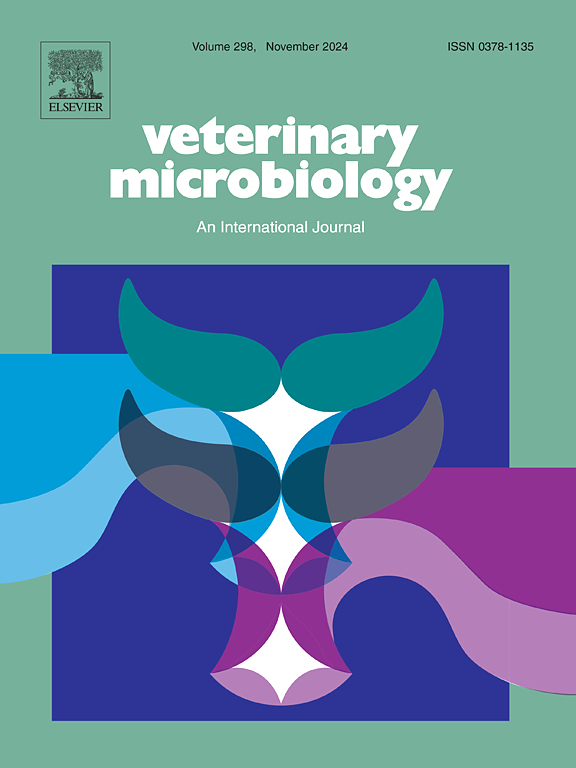韩国家禽业婴儿沙门氏菌pesi样巨质粒的基因组分析
IF 2.7
2区 农林科学
Q3 MICROBIOLOGY
引用次数: 0
摘要
据报道,新兴的婴儿沙门氏菌(pESI)质粒和pESI样质粒是婴儿沙门氏菌在世界范围内传播的主要原因,这些质粒在韩国也有报道。在这项研究中,8个pESI或pESI样质粒,包括2个来自韩国家禽业的婴儿链球菌的pESI样质粒,含有耶尔斯尼abactin操纵子、毒素/抗毒素系统和菌毛簇。有趣的是,在pESI样质粒中发现了多种抗性基因,而在pESI质粒中却没有。特别是,dfrA14,赋予对甲氧苄氨嘧啶的抗性,在7个pESI或pESI样质粒中有一个拷贝,但pM6-2-F5质粒中有两个拷贝。此外,插入序列26的拷贝数在7个pESI样质粒中均高于pESI质粒。本研究将来自各国携带pESI或pESI样质粒的40株婴儿链球菌(包括韩国的2株)分为2个聚类,聚类ⅰ鉴定为IncI1 ST71,聚类ⅱ鉴定为IncI1 ST209。16株代表IncI1 ST71携带blaCTX-M-65, 8株代表IncI1 ST209携带blaCTX-M-1。我们的研究为世界范围内家禽业的婴儿S. pesi样质粒提供了有价值的信息。本文章由计算机程序翻译,如有差异,请以英文原文为准。
Genomic analysis of pESI-like megaplasmid in Salmonella Infantis from the poultry industry in Korea
The plasmid of emerging Salmonella Infantis (pESI) and pESI-like plasmids have been reported as a major cause of the dissemination of S. Infantis worldwide, and these plasmids have also been reported in Korea. In this study, eight pESI or pESI-like plasmids, including two pESI-like plasmids of S. Infantis from the poultry industry in Korea, harbored yersiniabactin operon, toxin/antitoxin systems, and fimbria clusters. Interestingly, various resistance genes were identified in the pESI-like plasmids but not in the pESI plasmid. In particular, dfrA14, which confers resistance to trimethoprim, was harbored in one copy in seven pESI or pESI-like plasmids, but the pM6–2-F5 plasmid harbored two copies. Additionally, the copy number of insertion sequence 26 in seven pESI-like plasmids was higher than in the pESI plasmid. In this study, 40 S. Infantis strains carrying the pESI or pESI-like plasmids from various countries, including two strains in Korea, were classified into two clusters, with the plasmids identified as IncI1 ST71 in cluster I and IncI1 ST209 in cluster II. The 16 strains representing IncI1 ST71 harbored blaCTX-M-65, whereas the 8 strains representing IncI1 ST209 harbored blaCTX-M-1. Our study provides valuable information on the pESI-like plasmid in S. Infantis from the poultry industry worldwide.
求助全文
通过发布文献求助,成功后即可免费获取论文全文。
去求助
来源期刊

Veterinary microbiology
农林科学-兽医学
CiteScore
5.90
自引率
6.10%
发文量
221
审稿时长
52 days
期刊介绍:
Veterinary Microbiology is concerned with microbial (bacterial, fungal, viral) diseases of domesticated vertebrate animals (livestock, companion animals, fur-bearing animals, game, poultry, fish) that supply food, other useful products or companionship. In addition, Microbial diseases of wild animals living in captivity, or as members of the feral fauna will also be considered if the infections are of interest because of their interrelation with humans (zoonoses) and/or domestic animals. Studies of antimicrobial resistance are also included, provided that the results represent a substantial advance in knowledge. Authors are strongly encouraged to read - prior to submission - the Editorials (''Scope or cope'' and ''Scope or cope II'') published previously in the journal. The Editors reserve the right to suggest submission to another journal for those papers which they feel would be more appropriate for consideration by that journal.
Original research papers of high quality and novelty on aspects of control, host response, molecular biology, pathogenesis, prevention, and treatment of microbial diseases of animals are published. Papers dealing primarily with immunology, epidemiology, molecular biology and antiviral or microbial agents will only be considered if they demonstrate a clear impact on a disease. Papers focusing solely on diagnostic techniques (such as another PCR protocol or ELISA) will not be published - focus should be on a microorganism and not on a particular technique. Papers only reporting microbial sequences, transcriptomics data, or proteomics data will not be considered unless the results represent a substantial advance in knowledge.
Drug trial papers will be considered if they have general application or significance. Papers on the identification of microorganisms will also be considered, but detailed taxonomic studies do not fall within the scope of the journal. Case reports will not be published, unless they have general application or contain novel aspects. Papers of geographically limited interest, which repeat what had been established elsewhere will not be considered. The readership of the journal is global.
 求助内容:
求助内容: 应助结果提醒方式:
应助结果提醒方式:


